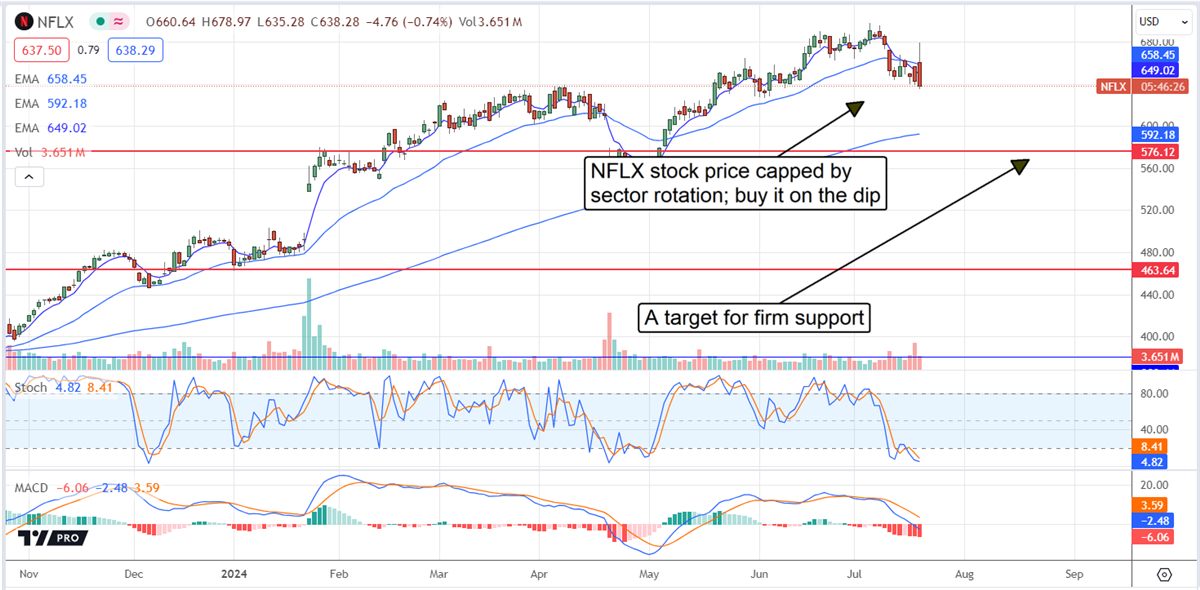Ticker Reports for July 21st
Safeguard Against Credit Card Risks with This Top Financial Stock
Now that the new earnings season has kicked off, the financial sector comes out swinging first, giving investors insights into what is happening underneath the hood of the economy, both the corporate and the commercial economy. This week, commercial banks like Bank of America Co. (NYSE: BAC) and J.P. Morgan Chase & Co. (NYSE: JPM) reported a not-so-shiny future in the consumer sector.
Rising credit card delinquencies, coupled with net charge-offs (accounts that are considered lost), encouraged management at these banks to put more capital away in case of further losses in the quarters to come. Investors can see that the banks are preparing themselves for another round of deterioration in consumer credit conditions. Still, there’s one way to hedge these risks away and also be exposed to what could be considered a consumer staple stock.
That stock is American Express (NYSE: AXP), which has just reported its second quarter 2024 earnings results to hold up the stock’s price in the middle of what could be this cycle’s biggest rotation out of the technology sector, mainly out of NVIDIA Co. (NASDAQ: NVDA) and into other areas like bonds and small-cap stocks. Here’s why American Express stock should be on more investor watchlists.
American Express Stock Flips the Script for Credit Sector
That’s a bold assessment, but it couldn’t be more true today. While the bigger commercial banks see their net interest income (NII) fall to burden earnings per share (EPS) on a stock, American Express will show investors a different story and allow them to tap into the better earning power in this household name.
According to the company’s earnings presentation for the second quarter of 2024, NII in American Express jumped by 20% over the year, beating the single-digit declines in the big banks.
This is important because, while most consumers are being choked by inflation and forced to miss their card payments, American Express’s customer profile shows that quality rather than quantity matters.
NII and other revenue growth at American Express drove the bottom-line earnings higher, pushing EPS growth of 44% in the past year. Watching Wall Street forecasts for only 14.8% EPS growth in the next 12 months makes it seem like analysts are falling on the conservative end of the spectrum.
Management leaned on this recent financial performance to provide even better guidance. Insiders feel that American Express can deliver EPS growth of 19% to 23% for the rest of the year, putting pressure on analysts to revise and boost their views.
Why Warren Buffett Owns American Express Stock and Plans to Keep It
Now, let's discuss why many investors, including Warren Buffett, continue to hold American Express stock. While the big banks see their charge-off and delinquency levels rise above pre-COVID levels today, American Express notes that both of these metrics are still below pre-COVID levels, meaning the business is better now than before the pandemic.
With this stability comes predictability, and that’s good for the company’s management, especially when the subject of reinvesting capital comes up. Management achieved this with up to $22.8 billion of free cash flow (operating cash flows minus capital expenditures) for the past 12 months.
First, it gave back up to $7 million in capital to investors through share buybacks, which delivered a message to the rest of the market. Part of this message is that insiders themselves may believe the stock to be on the cheap end today and that the near future could be filled with upside potential.
Over the past five years, American Express stock has repurchased an average of $3.5 billion worth of stock, which is one of the main strategies cash-flowing companies use to reward their shareholders once they reach these levels of stability and predictability in their cash flows.
This is also why Wall Street keeps being bullish on American Express stock. Analysts at Wells Fargo saw it fit to boost their price targets on American Express stock to $285 a share, daring it to rally by 19.2% from where it trades today.
Proposing these sorts of upsides and the stock delivering such a solid financial stance in the middle of one of the worst consumer credit markets had another impact on the market. American Express stock’s short interest collapsed by 10.4% in the past month, showing capitulation on the side of the bearish traders eyeing American Express.
That would explain why up to $9.8 billion of institutional capital was invested in American Express stock over the past 12 months, as the company is an easy target for these investors.
A lot of people are making this costly mistake
You may have heard the saying "options are risky" …
And, they can be. But only if you use them the way a lot of folks do.
A lot of people think of BUYING speculative options when they talk about options.
And BUYING low probability, speculative options is definitely risky…
It's how some folks leverage large sums of money hoping that a stock moves in the "right" direction over a certain period of time.
Streaming Titan's Stock Ready to Hit All-Time Highs This Year
Netflix's (NASDAQ: NFLX) stock price corrected about 5% ahead of its Q2 earnings release, and the correction may not be over now that the results are out, but it will soon result in a buying opportunity. Though mixed relative to analysts' consensus forecasts, the Q2 results were robust, featuring growth, margin expansion, and a forecast for increased capital returns, expected to drive higher stock prices over time.
The analysts' response has been favorable, and they are leading the market to new highs with their revisions. MarketBeat tracked a half-dozen revisions within the first 12 hours of the release, extending a trend that began last year, including an upward price target revision. The consensus assumes fair value at the current levels, but it is rising and may provide a floor for the market. However, the chance for a new all-time high is the critical detail for Netflix investors today. The analysts are leading the market to a range above consensus, which is good for a new all-time high.
Unlike other mega-tech leaders such as Meta Platforms (NASDAQ: META), this stock has yet to surpass its 2022 all-time highs, a significant technical milestone that can lead to accelerating price action. Meta Platforms, Microsoft (NASDAQ: MSFT), Alphabet (NASDAQ: GOOGL), and Oracle (NYSE: ORCL) crossed those levels last year and gained 25% or more after they did.
Netflix Hurdle Becomes A Tailwind
As problematic as the shift to ad-supported tiers was for Netflix's outlook, it has become a tailwind supporting the company’s growth. Netflix reported $9.56 billion in net revenue for a gain of 16.7%, outpacing the analyst consensus by 30 bps, on a 16% increase in paid memberships led by a 34% increase in ad-tier membership. Global paid customers grew by 8 million or 3%, with increased usage, ad-tiers, and pricing leading to margin strength.
Regionally, strength is centered in the US, with revenue per user up 7%. EEAC and LATAM produced FX-neutral growth offset by FX translation, while APAC revenue per user contracted on an FX-neutral and reported basis.
The margin news is best. The company widened its operating margin by 500 basis points and expects strength to continue. The increased margin led to accelerated income and earnings growth, with net income up 42% and GAAP earnings 48%. GAAP earnings outpaced consensus by 300 basis points and resulted in improved guidance.
Guidance is why the stock will move higher, given time. The company issued tepid guidance for Q2, falling below consensus, but still expecting 14% YoY growth and an acceleration from last year. The long-term outlook is more robust. The full-year revenue guidance was increased by 100 basis points at the low end, raising the mid-point to align with the analysts' consensus.
Netflix Builds Leverage for Investors
Netflix's cash flow and FCF are down marginally year over year due to FX translation but are still robust and sufficient to sustain the healthy balance sheet. The company continues to lean into programming and product development, which is the bulk of its spending, but it has ample cash flow left for share repurchases. The repurchases in Q2 topped $1.6 billion, reducing the count by 2.6% on average for the quarter, and there is still $5 billion left.
Highlights from the balance sheet include a cash reduction offset by increased assets, reduced liabilities, and improved shareholder equity. Equity is up 10% compared to last year. Because leverage remains low at 2x cash and 0.55x equity, the company can continue investing in growth, margin improvement, and capital returns.
Sector Rotation Saps Appetite for Netflix, Buy it on The Dip
Given the market environment, as good as Netflix's news is, it was insufficient to catalyze a strong rally. The June CPI report sparked a massive sector rotation from tech into small caps and blue chips that has yet to run its course. The takeaway is that Netflix share prices may move lower before they move higher, but higher prices and new all-time highs are forecasted. The critical target for support is near $635; provided that level holds, the rebound could begin soon. If not, NFLX shares could fall to the $600 level before finding solid support.

DOLLAR RECALL ON THE AGENDA
Have you heard about Executive Order 14067? This lesser-known order introduced the Digital Dollar, an alarming plan aimed at controlling your spending.
And it gets even more concerning: in November, the Federal Government and banks initiated a test program to implement the Digital Dollar.
Home Building Stock Hits 52-Week High With More Upside
D.R. Horton, Inc. (NYSE: DHI) is the largest homebuilder in the United States. D.R. Horton’s stock has been on a tear recently, with its stock price hitting a new 52-week high following a better-than-expected earnings announcement. D.R. Horton’s earnings for the third-quarter fiscal 2024 results revealed strong financial performance and a solid strategy for navigating current market challenges, suggesting continued growth and robust shareholder returns.
A Look at D.R. Horton's Performance
D.R. Horton's financial report for the third quarter highlighted several key metrics that underscore the company's financial health. Earnings per share (EPS) came in at $4.10, exceeding D.R. Horton’s analyst community’s expectations of $3.75 by $0.35. Revenue for the quarter reached $9.97 billion, surpassing the consensus estimate of $9.61 billion. The company also exceeded expectations for homes closed, delivering 24,155 new homes, a 5% increase year-over-year, compared to analyst expectations of 23,500 homes. These positive results indicate that D.R. Horton is effectively navigating the challenging market environment within the real estate sector.
However, the company's sales orders, a key indicator of future growth, were slightly below expectations. D.R. Horton recorded 23,001 new sales orders with a total value of $8.7 billion, falling short of the 24,664 orders and $9.31 billion in value predicted by analysts.
D.R. Horton's Strategy
Despite the economic challenges, the company's management highlighted their optimism about the housing market. They stated, "Although inflation and mortgage interest rates remain elevated, the supply of both new and existing homes at affordable price points is still limited, and demographics supporting housing demand continue to be favorable." This suggests that D.R. Horton believes the housing market's fundamentals will remain strong.
D.R. Horton employs a strategic approach centered on price and pace adjustments to address the current affordability challenges. The company is focused on maximizing returns at the community level, carefully balancing price with sales pace to achieve optimal results.
A vital element of the company's strategy is its focus on improving inventory turnover and shortening construction cycle times. D.R. Horton has seen significant progress in this area, with cycle times now below their historical average. This is attributed mainly to the company's consistent production and market scale, allowing it to secure necessary labor and resources. By optimizing these areas, D.R. Horton can manage its inventory more efficiently, leading to faster returns and increased cash flow.
A Focus on Shareholder Returns
D.R. Horton's commitment to shareholder returns is evident in its strong capital allocation strategy. The company's financial position is solid, characterized by low leverage and significant liquidity. This allows D.R. Horton to adapt to changing market conditions and make strategic investments.
The company recently announced a new $4 billion share repurchase authorization, signaling its intention to increase shareholder returns further. This authorization has no expiration date, suggesting a long-term commitment to reducing shares outstanding. D.R. Horton's dividend, which has been consistently increasing over the last several years, is another component of its shareholder return strategy.
D.R. Horton's Rental Business
D.R. Horton's rental business segment is a key growth driver for the company. It has seen significant expansion in both single-family and multifamily rental properties. The company's approach to this segment is focused on building purpose-built rental communities and selling them to investors. This strategy offers several benefits, including enhanced purchasing scale and opportunities for efficient utilization of resources.
The company's current inventory balance for the rental business is about one-third single-family and two-thirds multifamily. While the current mix is weighted towards multifamily, D.R. Horton expects this to shift slightly towards single-family rental in the future. However, the company has yet to determine a target balance for the mix, as it depends on market demand and community-level considerations.
D.R. Horton's Land and Lot Strategy
D.R. Horton's land and lot strategy is crucial to its success. The company maintains a significant owned and controlled lot position, with over 630,000 lots at the end of the third quarter. A key aspect of this strategy is the company's close relationship with Forestar Group Inc. (NYSE: FOR). This publicly traded residential lot development company is a majority-owned subsidiary of D.R. Horton.
Forestar plays a vital role in D.R. Horton's land and lot strategy. It provides a substantial portion of the company's finished lots for its homebuilding and rental operations. This partnership allows D.R. Horton to maintain a consistent supply of lots, mitigating the risk of delays and cost increases that can arise from land shortages.
While D.R. Horton's reliance on Forestar is significant, the company also leverages a network of lot development partnerships nationwide. This strategy has proven successful, enabling D.R. Horton to access a broader range of lots, diversify its land holdings, and increase flexibility.
However, D.R. Horton acknowledges that lot costs are rising, and the company does not expect this trend to moderate significantly in the near future. Lot costs are a crucial driver of overall homebuilding costs and represent a significant headwind for homebuilders. The company's ability to manage these rising costs effectively will be a critical factor in its future profitability.
Community Count Growth
D.R. Horton's community count has expanded significantly in recent years, playing a crucial role in its market share gains. While the company expects this growth to be moderate, it is committed to maintaining a healthy pace of community expansion to fuel its ongoing development.
D.R. Horton is strategically expanding into new markets, often accompanied by acquiring land and lots. This strategy provides the company with a steady supply of new communities to develop, further strengthening its position as a market leader.
A Strong Contender in the Housing Market
D.R. Horton's recent performance highlights its strong financial foundation, strategic approach to market challenges, and continued growth potential. The company's focus on shareholder returns through share repurchases and dividends, its expanding rental business, and its commitment to community count growth make it a compelling stock for investors interested in the housing market. D.R. Horton's solid performance and strategic vision make it a strong contender in the housing market, positioned for continued success.





